Shah Jahan
Shahab-ud-din Muhammad Khurram[3] (5 January 1592 – 22 January 1666),[7] better known by his regnal name Shah Jahan (Persian: شاه جهان; "King of the World"),[8] was the fifth Mughal emperor, who reigned from 1628 to 1658.[9] He is widely considered one of the greatest Mughal emperors; under his reign the Mughal Empire reached the peak of its glory.[10] Although an able military commander, Shah Jahan is perhaps best remembered for his architectural achievements. His reign ushered in the golden age of Mughal architecture. Shah Jahan commissioned many monuments, the best known of which is the Taj Mahal in Agra, which entombs his favourite wife, Mumtaz Mahal. His relationship with Mumtaz Mahal has been heavily adapted into Indian art, literature, and cinema.
| Shahab-ud-din Muhammad Shah Jahan شهاب الدین محمد شاہ جهان | |||||||||
|---|---|---|---|---|---|---|---|---|---|
| Padishah of the Mughal Empire Shah Jahan | |||||||||
.jpg) Shah Jahan | |||||||||
| 5th Mughal Emperor | |||||||||
| Reign | 19 January 1628 –31 July 1658[1] | ||||||||
| Coronation | 14 February 1628,[2] Agra | ||||||||
| Predecessor | Shahryar Mirza (de facto) Jahangir | ||||||||
| Successor | Aurangzeb | ||||||||
| Born | Shahab-ud-din Muhammad Khurram[3] 5 January 1592 Lahore, Mughal Empire | ||||||||
| Died | 22 January 1666 (aged 74) Agra Fort, Agra, Mughal Empire | ||||||||
| Burial | Taj Mahal, Agra | ||||||||
| Consort | Mumtaz Mahal | ||||||||
| Wives |
| ||||||||
| Issue among others... |
| ||||||||
| |||||||||
| House | Timurid | ||||||||
| Father | Jahangir | ||||||||
| Mother | Jagat Gosain | ||||||||
| Religion | Sunni Islam | ||||||||
|
||||||||||||||||||||||||||||||||||||||||||
Shah Jahan was considered the most competent of Emperor Jahangir's four sons. Jahangir's death in late 1627 spurred a war of succession from which Shah Jahan emerged victorious after much intrigue. He put to death all of his rivals for the throne and crowned himself emperor in January 1628 in Agra under the regnal title "Shah Jahan" (which was originally given to him as a princely title). His rule saw many grand building projects, including the Red Fort and the Shah Jahan Mosque. Foreign affairs saw war with the Safavids and conflict with the Portuguese, but positive relations with the Ottoman Empire. Domestic concerns included putting down numerous rebellions, and a devastating famine from 1630-32.
In September 1657, Shah Jahan fell seriously ill. This set off a war of succession among his four sons in which his third son, Aurangzeb, emerged victorious and usurped his father.[11] Shah Jahan recovered from his illness, but Aurangzeb put his father under house arrest in Agra Fort from July 1658 until his death in January 1666.[12] He was laid to rest next to his wife in the Taj Mahal.
Early life
Birth and background
Shahab-ud-din Muhammad Khurram was born on 5 January 1592 in Lahore, in modern-day Pakistan, and was the third son of Prince Salim (later known as 'Jahangir' upon his accession).[13] His mother was a Rajput princess from Marwar called Princess Jagat Gosaini (her official name in Mughal chronicles was Bilqis Makani). The name "Khurram" (joyous) was chosen for the young prince by his grandfather, Emperor Akbar, with whom the young prince shared a close relationship.[13]
Just prior to Khurram's birth, a soothsayer had reportedly predicted to the childless Empress Ruqaiya Sultan Begum, Akbar's first wife and chief consort, that the still unborn child was destined for imperial greatness.[14] So, when Khurram was born in 1592 and was only six days old, Akbar ordered that the prince be taken away from his mother and handed over to Ruqaiya so that he could grow up under her care, and Akbar could fulfil his wife's wish to raise a Mughal emperor.[14] Ruqaiya assumed the primary responsibility for Khurram's upbringing and he grew up under her care.[15] The two shared a close relationship with each other. Jahangir noted in his memoirs that Ruqaiya had loved his son, Khurram, "a thousand times more than if he had been her own [son]."[16]
Khurram remained with her until he turned almost 14. After Akbar's death in 1605, the young prince was allowed to return to his father's household, and thus, be closer to his biological mother.[14]
Education
As a child, Khurram received a broad education befitting his status as a Mughal prince, which included martial training and exposure to a wide variety of cultural arts, such as poetry and Hindustani classical music, most of which was inculcated, according to court chroniclers, by Akbar and Ruqaiya. In 1605, as Akbar lay on his deathbed, Khurram, who at this point was 13,[17] remained by his bedside and refused to move even after his mother tried to retrieve him. Given the politically uncertain times immediately preceding Akbar's death, Khurram was in a fair amount of physical danger from political opponents of his father,[18] His conduct at this time can be understood as a precursor to the bravery that he would later be known for.
Khusrau rebellion
In 1605, his father succeeded to the throne, after crushing a rebellion by Prince Khusrau – Khurram remained distant from court politics and intrigues in the immediate aftermath of that event, which was apparently a conscious decision on Jahangir's part.[19] As the third son, Khurram did not challenge the two major power blocs of the time, his father's and his step-brother's; thus, he enjoyed the benefits of imperial protection and luxury while being allowed to continue with his education and training.[20] This relatively quiet and stable period of his life allowed Khurram to build his own support base in the Mughal court, which would be useful later on in his life.
Nur Jahan
Due to the long period of tensions between his father and step-brother, Khurram began to drift closer to his father and over time started to be considered the de facto heir-apparent by court chroniclers. This status was given official sanction when Jahangir granted the sarkar of Hissar-Feroza, which had traditionally been the fief of the heir-apparent, to Khurram in 1608.[21] Nur Jahan was an intelligent and beautiful lady with an excellent educational background. She was an active participant in the decisions made by Jahangir. Slowly and gradually, she became the actual power behind the throne, as Jahangir became more indulgent in wine and opium. Coins began to be struck containing her name along with Jahangir's name. Her near and dear relatives acquired important positions in the Mughal court, termed as the Nur Jahan junta by historians. After the death of Jahangir in 1627, Nur Jahan was put under house arrest and led a quiet life.
Marriages
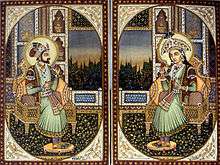
In 1607, Khurram became engaged to Arjumand Banu Begum (1593–1631), who is also known as Mumtaz Mahal (Persian for "the chosen one of the Palace"). They met in their youth. They were about 14 and 15 when they were engaged, and five years later they got married. The young girl belonged to an illustrious Persian noble family that had been serving Mughal Emperors since the reign of Akbar. The family's patriarch was Mirza Ghiyas Beg, who was also known by his title I'timād-ud-Daulah or "Pillar of the State". He had been Jahangir's finance minister and his son, Asaf Khan – Arjumand Banu's father – played an important role in the Mughal court, eventually serving as Chief Minister. Her aunt was the Empress Nur Jahan and is thought to have played matchmaker in arranging the marriage.
The prince would have to wait five years before he was married in 1612 (1021 AH), on a date selected by the court astrologers as most conducive to ensuring a happy marriage. This was an unusually long engagement for the time. However, Shah Jahan first married Princess Kandahari Begum, the daughter of a great-grandson of Shah Ismail I of Persia with whom he had a daughter, his first child.[22]

Politically speaking, the betrothal allowed Khurram to be considered as having officially entered manhood, and he was granted several jagir, including Hissar-Feroze and ennobled to a military rank of 8,000, which allowed him to take on official functions of the state, an important step in establishing his own claim to the throne.
In 1612, aged 20, Khurram married Arjumand Banu Begum, who became known by the title Mumtaz Mahal, on the auspicious date chosen by court astrologers. The marriage was a happy one and Khurram remained devoted to her. She bore him fourteen children, out of whom seven survived into adulthood. In addition, Khurram had two children from his first two wives.[22]
Though there was genuine love between the two, Arjumand Banu Begum was a politically astute woman and served as a crucial advisor and confidante to her husband.[23] Later on, as empress, Mumtaz Mahal wielded immense power, such as being consulted by her husband in state matters and being responsible for the imperial seal, which allowed her to review official documents in their final draft.
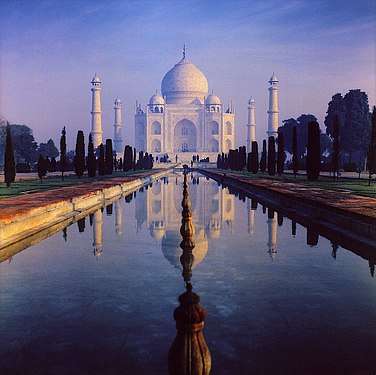
Mumtaz Mahal died at age 38 (7 July 1631) while giving birth to Gauhara Begum in Burhanpur. She died of a postpartum haemorrhage, which caused considerable blood-loss after a painful labour of thirty hours.[24] Contemporary historians note that Princess Jahanara, aged 17, was so distressed by her mother's pain that she started distributing gems to the poor, hoping for divine intervention, and Shah Jahan was noted as being "paralysed by grief" and weeping fits.[25] Her body was temporarily buried in a walled pleasure garden known as Zainabad, originally constructed by Shah Jahan's uncle Prince Daniyal along the Tapti River. Her death had a profound impact on Shah Jahan's personality and inspired the construction of the Taj Mahal, where she was later reburied.
In the intervening years Khurram had taken eight other wives, among which Kandahari Begum (m. 12 December 1609) and Izz un-Nisa Begum (m. 3 September 1617), the daughters of Muzaffar Husain Mirza Safawi and Shahnawaz Khan, son of Abdul Rahim Khan-I-Khana, respectively. But according to court chroniclers, his relationship with his other wives was more out of political consideration, and they enjoyed only the status of being royal wives.[17]
Early military campaigns
Prince Khurram showed extraordinary military talent. The first occasion for Khurram to test his military prowess was during the Mughal campaign against the Rajput state of Mewar, which had been a hostile force to the Mughals since Akbar's reign. In 1614, commanding an army numbering around 200,000, Khurram began the campaign against Mewar. After a year of a harsh war of attrition, Maharana Amar Singh I surrendered conditionally to the Mughal forces and became a vassal state of the Mughal Empire.[26]
In 1617, Khurram was directed to deal with the Lodis in the Deccan to secure the Empire's southern borders and to restore imperial control over the region. His successes in these campaigns led to Jahangir granting him the title of Shah Jahan (Persian: "King of the World") and raised his military rank and allowed him a special throne in his Durbar, an unprecedented honour for a prince, thus further solidifying his status as crown prince.Edward S. Holden writes, "He was flattered by some, envied by others, loved by none."[27]
Rebel prince
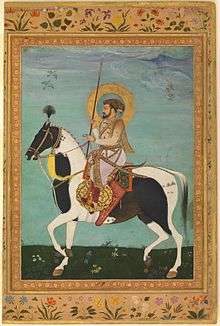
Inheritance of power and wealth in the Mughal empire was not determined through primogeniture, but by princely sons competing to achieve military successes and consolidating their power at court. This often led to rebellions and wars of succession. As a result, a complex political climate surrounded the Mughal court in Khurram's formative years. In 1611 his father married Nur Jahan, the widowed daughter of a Persian noble. She rapidly became an important member of Jahangir's court and, together with her brother Asaf Khan, wielded considerable influence. Arjumand was Asaf Khan's daughter and her marriage to Khurram consolidated Nur Jahan and Asaf Khan's positions at court.
Court intrigues, however, including Nur Jahan's decision to have her daughter from her first marriage wed Prince Khurram's youngest brother Shahzada Shahryar and her support for his claim to the throne led to much internal division. Prince Khurram resented the influence Nur Jahan held over his father and was angered at having to play second fiddle to her favourite Shahryar, his half-brother and her son-in-law. When the Persians besieged Kandahar, Nur Jahan was at the helm of the affairs. She ordered Prince Khurram to march for Kandahar, but he refused. As a result of Prince Khurram's refusal to obey Nur Jahan's orders, Kandahar was lost to the Persians after a forty-five-day siege. Prince Khurram feared that in his absence Nur Jahan would attempt to poison his father against him and convince Jahangir to name Shahryar the heir in his place. This fear brought Prince Khurram to rebel against his father rather than fight against the Persians. In 1622 Prince Khurram raised an army with the support of Mahabat Khan and marched against his father and Nur Jahan.. He was defeated at Bilochpur in March 1623. Later he took refuge in Udaipur Mewar with Maharaja Karan Singh II . He was first lodged in Delwada Ki Haveli and subsequently shifted to Jagmandir Palace on his request. Prince Khurram exchanged his turban with maharana and that turban is still preserved in Pratap Museum, Udaipur.(R V Somani 1976). It is believed that the mosaic work of Jagmandir inspired him to use mosaic work in the Taj Mahal of Agra. His rebellion did not succeed and Khurram was forced to submit unconditionally. Although the prince was forgiven for his errors in 1626, tensions between Nur Jahan and her stepson continued to grow beneath the surface.
Upon the death of Jahangir in 1627, the wazir Asaf Khan, who had long been a quiet partisan of Prince Khurram, acted with unexpected forcefulness and determination to forestall his sister the empress Nur Jahan's plans to place Prince Shahryar on the throne. He put Nur Jahan in close confinement. He obtained control of Prince Khurram's three sons who were under her care. Asaf Khan also managed palace intrigues to ensure Prince Khurram's succession the throne.[28] Prince Khurram succeeded to the Mughal throne as Abu ud-Muzaffar Shihab ud-Din Mohammad Sahib ud-Quiran ud-Thani Shah Jahan Padshah Ghazi (Urdu: شهاب الدین محمد خرم), or Shah Jahan.[29]
His regnal name is divided into various parts. Shihab ud-Din mean "Star of the Faith", Sahib al-Quiran ud-Thani means "Second Lord of the Happy Conjunction of Jupiter and Venus". Shah Jahan means "King of the World", alluding to his pride in his Timurid roots and his ambitions. More epithets showed his secular and religious duties. He was also Khalifat Panahi ("Refuge of the Caliphate"), but Zill-i Allahi, or the "Shadow of God on Earth".
His first act as ruler was to execute his chief rivals and imprison his stepmother Nur Jahan. Upon Shah Jahan's orders several executions took place on 23 January 1628. Those put to death included his own brother Shahryar; his nephews Dawar and Garshasp, sons of Shah Jahan's previously executed brother Prince Khusrau; and his cousins Tahmuras and Hoshang, sons of the late Prince Daniyal Mirza.[30][31] This allowed Shah Jahan to rule his empire without contention.
Reign (1628–1658)
Administration of the Mughal Empire
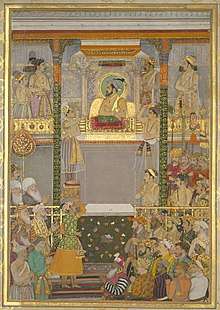
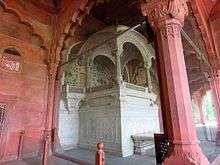
Evidence from the reign of Shah Jahan states that in 1648 the army consisted of 911,400 infantry, musketeers, and artillery men, and 185,000 Sowars commanded by princes and nobles.
His cultural and political initial steps have been described as a type of the Timurid Renaissance, in which he built historical and political bonds with his Timurd heritage mainly via his numerous unsuccessful military campaigns on his ancestral region of Balkh. In various forms, Shah Jahan appropriated his Timurid background and grafted it onto his imperial legacy.[32]
During his reign the Marwari horse was introduced, becoming Shah Jahan's favourite, and various Mughal cannons were mass-produced in the Jaigarh Fort. Under his rule, the empire became a huge military machine and the nobles and their contingents multiplied almost fourfold, as did the demands for more revenue from their citizens. But due to his measures in the financial and commercial fields, it was a period of general stability—the administration was centralised and court affairs systematised.
The Mughal Empire continued to expand moderately during his reign as his sons commanded large armies on different fronts. India at the time was a rich centre of the arts, crafts and architecture, and some of the best of the architects, artisans, craftsmen, painters and writers of the world resided in Shah Jahan's empire. According to economist Angus Maddison, Mughal-era India's share of global gross domestic product (GDP) grew from 22.7% in 1600 to 24.4% in 1700, surpassing China to become the world's largest.[33][34]
Rajput rebellions
Shah Jahan annexed the Rajput kingdoms of Baglana, Mewar and Bundelkhand. He then chose his 16-year-old son Aurangzeb to serve in his place and subdue the rebellion by the Bundela Rajputs led by Jhujhar Singh.
Famine of 1630
A famine broke out in 1630–32 in Deccan, Gujarat and Khandesh as a result of three main crop failures.[35] Two million died of starvation, grocers sold dogs' flesh and mixed powdered bones with flour. Parents ate their own children. Some villages were completely destroyed, their streets filled with human corpses. In response to the devastation, Shah Jahan set up langar (free kitchens) for the victims of the famine.[36]
Relations with the Deccan Sultanates
In 1632, Shah Jahan captured the fortress at Daulatabad, Maharashtra and imprisoned Husain Shah of the Nizam Shahi Kingdom of Ahmednagar. Golconda submitted in 1635 and then Bijapur in 1636. Shah Jahan appointed Aurangzeb as Viceroy of the Deccan, consisting of Khandesh, Berar, Telangana, and Daulatabad. During his viceroyalty, Aurangzeb conquered Baglana, then Golconda in 1656, and then Bijapur in 1657.[37]
Sikh rebellion led by Guru Hargobind
A rebellion of the Sikhs led by Guru Hargobind took place and in return Shah Jahan ordered the destruction of the Sikh temple in Lahore.
Relations with the Safavid dynasty
.jpg)
Shah Jahan and his sons captured the city of Kandahar in 1638 from the Safavids, prompting the retaliation of the Persians led by their ruler Abbas II of Persia, who recaptured it in 1649.
The Mughal armies were unable to recapture it despite repeated sieges during the Mughal–Safavid War.[38] Shah Jahan also expanded the Mughal Empire to the west beyond the Khyber Pass to Ghazna and Kandahar.
Relations with the Ottoman Empire
While he was encamped in Baghdad, the Ottoman Sultan Murad IV met Shah Jahan's ambassadors, Mir Zarif and Mir Baraka, who presented 1000 pieces of finely embroidered cloth and even armour. Murad IV presented them with the finest weapons, saddles and Kaftans and ordered his forces to accompany the Mughals to the port of Basra, where they set sail to Thatta and finally Surat.[39]
War with Portuguese
Shah Jahan gave orders in 1631 to Qasim Khan, the Mughal viceroy of Bengal, to drive out the Portuguese from their trading post at Port Hoogly. The post was heavily armed with cannons, battleships, fortified walls, and other instruments of war.[40] The Portuguese were accused of trafficking by high Mughal officials and due to commercial competition the Mughal-controlled port of Saptagram began to slump. Shah Jahan was particularly outraged by the activities of Jesuits in that region, notably when they were accused of abducting peasants. On 25 September 1632 the Mughal Army raised imperial banners and gained control over the Bandel region and the garrison was punished.[41]
Ministers
Shah Jahan's treasurer was Sheikh Farid, who founded the city of Faridabad.
Later life
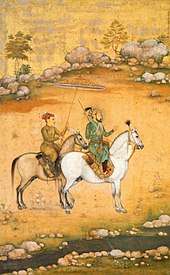
When Shah Jahan became ill in 1658, Dara Shikoh (Mumtaz Mahal's eldest son) assumed the role of regent in his father's stead, which swiftly incurred the animosity of his brothers. Upon learning of his assumption of the regency, his younger brothers, Shuja, Viceroy of Bengal, and Murad Baksh, Viceroy of Gujarat, declared their independence and marched upon Agra in order to claim their riches. Aurangzeb, the third son, gathered a well-trained army and became its chief commander. He faced Dara's army near Agra and defeated him during the Battle of Samugarh. Although Shah Jahan fully recovered from his illness, Aurangzeb declared him incompetent to rule and put him under house arrest in Agra Fort.
Jahanara Begum Sahib, Mumtaz Mahal's first daughter, voluntarily shared his 8-year confinement and nursed him in his dotage. In January 1666, Shah Jahan fell ill. Confined to bed, he became progressively weaker until, on 22 January, he commended the ladies of the imperial court, particularly his consort of later years Akbarabadi Mahal, to the care of Jahanara. After reciting the Kal'ma (Laa ilaaha ill allah) and verses from the Quran, Shah Jahan died, aged 74.
Shah Jahan's chaplain Sayyid Muhammad Qanauji and Kazi Qurban of Agra came to the fort, moved his body to a nearby hall, washed it, enshrouded it and put it in a coffin of sandalwood.[23]
Princess Jahanara had planned a state funeral which was to include a procession with Shah Jahan's body carried by eminent nobles followed by the notable citizens of Agra and officials scattering coins for the poor and needy. Aurangzeb refused to accommodate such ostentation. The body was taken to the Taj Mahal and was interred there next to the body of his beloved wife Mumtaz Mahal.[42]
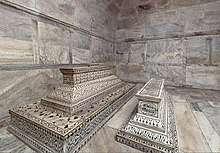
Contributions to architecture
Shah Jahan left behind a grand legacy of structures constructed during his reign. He was one of the greatest patrons of Mughal architecture.[43] His most famous building was the Taj Mahal, which he built out of love for his wife, the empress Mumtaz Mahal.
Its structure was drawn with great care and architects from all over the world were called for this purpose. The building took twenty years to complete and was constructed from white marble underlaid with brick. Upon his death, his son Aurangzeb had him interred in it next to Mumtaz Mahal. Among his other constructions are the Red Fort also called the Delhi Fort or Lal Qila in Urdu, large sections of Agra Fort, the Jama Masjid, the Wazir Khan Mosque, the Moti Masjid, the Shalimar Gardens, sections of the Lahore Fort, the Mahabat Khan Mosque in Peshawar, the Mini Qutub Minar[44] in Hastsal, the Jahangir mausoleum—his father's tomb, the construction of which was overseen by his stepmother Nur Jahan and the Shahjahan Mosque. He also had the Peacock Throne, Takht e Taus, made to celebrate his rule. Shah Jahan also placed profound verses of the Quran on his masterpieces of architecture.
The Shah Jahan Mosque in Thatta, Sindh province of Pakistan (100 km / 60 miles from Karachi) was built during the reign of Shah Jahan in 1647. The mosque is built with red bricks with blue coloured glaze tiles probably imported from another Sindh's town of Hala. The mosque has overall 93 domes and it is the world's largest mosque having such a number of domes. It has been built keeping acoustics in mind. A person speaking inside one end of the dome can be heard at the other end when the speech exceeds 100 decibels. It has been on the tentative UNESCO World Heritage list since 1993.[45]
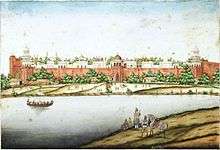
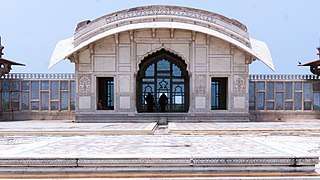 The elegant Naulakha Pavilion at the Lahore Fort was built during the reign of Shah Jahan.
The elegant Naulakha Pavilion at the Lahore Fort was built during the reign of Shah Jahan.
 Shah Jahan and the Mughal Army return after attending a congregation in the Jama Masjid, Delhi.
Shah Jahan and the Mughal Army return after attending a congregation in the Jama Masjid, Delhi.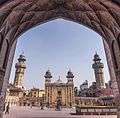 Lahore's Wazir Khan Mosque is considered to be the most ornate Mughal-era mosque.[46]
Lahore's Wazir Khan Mosque is considered to be the most ornate Mughal-era mosque.[46]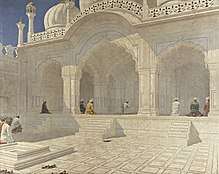
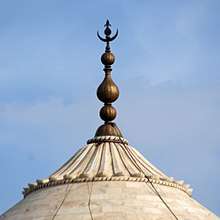
Coins
Shah Jahan continued striking coins in three metals i.e. gold (mohur), silver (rupee) and copper (dam). His pre-accession coins bear the name Khurram.
 Gold Mohur from Akbarabad (Agra)
Gold Mohur from Akbarabad (Agra) Silver rupee coin of Shah Jahan, from Patna.
Silver rupee coin of Shah Jahan, from Patna. Copper Dam from Daryakot mint
Copper Dam from Daryakot mint Silver Rupee from Multan
Silver Rupee from Multan
Full title
| Styles of Shah Jahan | |
|---|---|
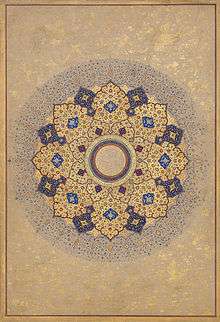 | |
| Reference style | Shahanshah |
| Spoken style | His Imperial Majesty |
| Alternative style | Alam Pana |
Shah Jahan's full imperial title was:
Shahanshah Al-Sultan al-'Azam wal Khaqan al-Mukarram, Malik-ul-Sultanat, Ala Hazrat Abu'l-Muzaffar Shahab ud-din Muhammad Shah Jahan I, Sahib-i-Qiran-i-Sani, Padshah Ghazi Zillu'llah, Firdaus-Ashiyani, Shahanshah—E—Sultanant Ul Hindiya Wal Mughaliya
Gallery
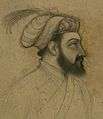 Single Leaf of a Portrait of Shah Jahan.
Single Leaf of a Portrait of Shah Jahan.- Shah Jahan
Issue
| Name | Portrait | Lifespan | Notes |
|---|---|---|---|
| Parhez Banu Begum | 21 August 1611 - 1675 |
Shah Jahan's first child born to his first wife, Kandahari Begum. Parhez Banu was her mother's only child and died unmarried. | |
| Hur-al-Nisa Begum | 30 March 1613 - 5 June 1616 |
The first of fourteen children born to Shah Jahan's second wife, Mumtaz Mahal. She died of smallpox at the age of 3.[47] | |
| Jahanara Begum Padshah Begum |
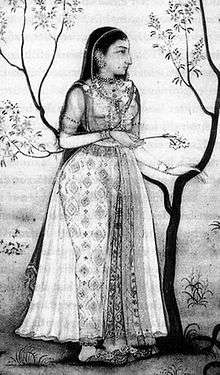 |
23 March 1614 - 16 September 1681 |
Shah Jahan's favourite and most influential daughter. Jahanara became the First Lady (Padshah Begum) of the Mughal Empire after her mother's death, despite the fact that her father had three other consorts. She died unmarried. |
| Dara Shikoh Padshahzada-i-Buzurg Martaba, Jalal ul-Kadir, Sultan Muhammad Dara Shikoh, Shah-i-Buland Iqbal |
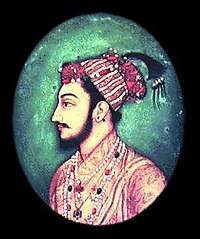 |
20 March 1615 - 30 August 1659 |
The eldest son and heir-apparent. He was favoured as a successor by his father, Shah Jahan, and his elder sister, Princess Jahanara Begum, but was defeated and later killed by his younger brother, Prince Muhiuddin (later the Emperor Aurangzeb), in a bitter struggle for the imperial throne. He married and had issue. |
| Shah Shuja | .jpg) |
23 June 1616 - 7 February 1661 |
He survived in the war of succession. He married and had issue. |
| Roshanara Begum Padshah Begum |
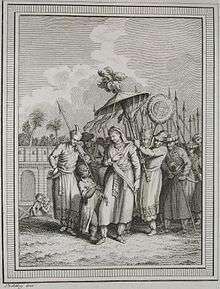 |
3 September 1617 - 11 September 1671 |
She was the most influential of Shah Jahan's daughters after Jahanara Begum and sided with Aurangzeb during the war of succession. She died unmarried. |
| Jahan Afroz | 25 June 1618 - March 1619 |
The only child of Shah Jahan's third wife, Izz-un-Nissa (titled Akbarabadi Mahal). Jahan Afroz died at the age of one year and nine months.[48] | |
| Aurangzeb Mughal emperor |
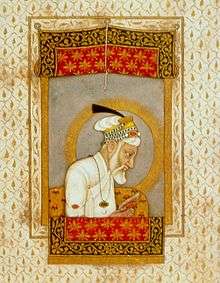 |
3 November 1618 - 3 March 1707 |
Succeeded his father as the sixth Mughal emperor after emerging victorious in the war of succession that took place after Shah Jahan's illness in 1657. |
| Izad Bakhsh | 18 December 1619 - February/March 1621[49] |
Died in infancy. | |
| Surayya Banu Begum | 10 June 1621 - 28 April 1628[49] |
Died of smallpox at the age of 7.[47] | |
| Unnamed son | 1622 | Died soon after birth.[49] | |
| Murad Bakhsh | 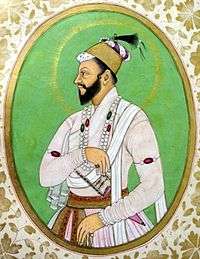 |
8 October 1624 - 14 December 1661 |
He was killed in 1661 as per Aurangzeb's orders.[47] He married and had issue. |
| Lutf Allah | 4 November 1626 - 13 May 1628[49] |
Died at the age of one and a half years.[47] | |
| Daulat Afza | 8 May 1628 - 13 May 1629[50] |
Died in infancy. | |
| Husnara Begum | 23 April 1629 - 1630[49] |
Died in infancy. | |
| Gauhara Begum | 17 June 1631 - 1706 |
Mumtaz Mahal died while giving birth to her on 17 June 1631 in Burhanpur. She died unmarried. | |
| Purhanara Begum | died After 1666 | ? | |
| Nazarara Begum | ? | ? |
Ancestry
| Ancestors of Shah Jahan | |||||||||||||||||||||||||||||||||||||||||||||||||||||||||||||||||||||||||||||||||||||||||||||||||||||||||||||||||||||||||||||||||||||||||||||||||||||||||||||||||||||||||||||||||||||||||||||||||||||||||||||||||||||||||||||||||||||||||||||||||||||||||||||||||||||||||
|---|---|---|---|---|---|---|---|---|---|---|---|---|---|---|---|---|---|---|---|---|---|---|---|---|---|---|---|---|---|---|---|---|---|---|---|---|---|---|---|---|---|---|---|---|---|---|---|---|---|---|---|---|---|---|---|---|---|---|---|---|---|---|---|---|---|---|---|---|---|---|---|---|---|---|---|---|---|---|---|---|---|---|---|---|---|---|---|---|---|---|---|---|---|---|---|---|---|---|---|---|---|---|---|---|---|---|---|---|---|---|---|---|---|---|---|---|---|---|---|---|---|---|---|---|---|---|---|---|---|---|---|---|---|---|---|---|---|---|---|---|---|---|---|---|---|---|---|---|---|---|---|---|---|---|---|---|---|---|---|---|---|---|---|---|---|---|---|---|---|---|---|---|---|---|---|---|---|---|---|---|---|---|---|---|---|---|---|---|---|---|---|---|---|---|---|---|---|---|---|---|---|---|---|---|---|---|---|---|---|---|---|---|---|---|---|---|---|---|---|---|---|---|---|---|---|---|---|---|---|---|---|---|---|---|---|---|---|---|---|---|---|---|---|---|---|---|---|---|---|---|---|---|---|---|---|---|---|---|---|---|---|---|---|---|---|
| |||||||||||||||||||||||||||||||||||||||||||||||||||||||||||||||||||||||||||||||||||||||||||||||||||||||||||||||||||||||||||||||||||||||||||||||||||||||||||||||||||||||||||||||||||||||||||||||||||||||||||||||||||||||||||||||||||||||||||||||||||||||||||||||||||||||||
References
Notes
- Shujauddin, Mohammad; Shujauddin, Razia (1967). The Life and Times of Noor Jahan. Lahore: Caravan Book House. p. 121. OCLC 638031657.
- Necipoğlu, Gülru, ed. (1994). Muqarnas : an annual on Islamic art and architecture. Volume 11. Leiden, Netherlands: E.J. Brill. p. 143. ISBN 978-90-04-10070-1.
- Singh, Pashaura; Fenech, Louis E., eds. (2014). The Oxford handbook of Sikh studies. Oxford University Press. p. 649. ISBN 978-0-19-969930-8.
- Richards 1993, p. 127
- Koch 2006, p. 120
- Flood, Finbarr Barry; Necipoglu, Gulru (2017). A Companion to Islamic Art and Architecture. John Wiley & Sons. p. 897. ISBN 978-1-119-06857-0.
- "Shah Jahan". Encyclopædia Britannica.
- Middleton, John (2015). World Monarchies and Dynasties. Routledge. p. 451. ISBN 978-1-317-45158-7.
- Gonzalez, Valerie (2016). Aesthetic Hybridity in Mughal Painting, 1526–1658. Routledge. p. 116. ISBN 978-1-317-18487-4.
- Mehta, Jaswant Lal (1986). Advanced Study in the History of Medieval India. Sterling Publishers Pvt. Ltd. p. 59. ISBN 978-8120710153.
- Richards 1993, p. 158
- Illustrated dictionary of the Muslim world. Tarrytown, NY: Marshall Cavendish Reference. 2011. p. 136. ISBN 978-0-7614-7929-1.
- Findly 1993, p. 125
- Faruqui, Munis D. (2012). Princes of the Mughal Empire, 1504–1719. Cambridge University Press. p. 71. ISBN 978-1-107-02217-1.
- Eraly 2000, p. 299
- Jahangir (1968). Henry Beveridge (ed.). The Tūzuk-i-Jahāngīrī: or, Memoirs of Jāhāngīr, Volumes 1–2. Munshiram Manoharlal. p. 48.
- Qazvini, Asad Beg; Mughal-era historian
- Prasad 1930, p. 189 "During his grandfather's last illness, he [Khurram] refused to leave the bedside surrounded by his enemies. Neither the advice of his father nor the entreaties of his mother could prevail on him to prefer the safety of his life to his last duty to the old man."
- Jahangir, Tuzk-e-Jahangiri; The Emperor's memoirs
- Nicoll 2009, p. 56
- Prasad 1930, p. 190 "Khusrau conspired, rebelled, and lost the favour of his father ... Of all the sons of Jahangir, Khurram was marked out to be the heir-apparent and successor ... In 1608 the assignment of the sarkar of Hissar Firoz to him proclaimed to the world that he was intended for the throne.
- Eraly 2000, p. 300
- Eraly 2000, p. 379
- Kumar, Anant (January–June 2014). "Monument of Love or Symbol of Maternal Death: The Story Behind the Taj Mahal". Case Reports in Women's Health. 1: 4–7. doi:10.1016/j.crwh.2014.07.001. Retrieved 21 December 2015.
- Nicoll 2009, p. 177
- Prasad 1930, p. 239 "Constant skirmishes were thinning the Rajput ranks ... [Amar Singh] offered to recognize Mughal supremacy ... Jahangir gladly and unreservedly accepted the terms."
- Holden, Edward S. (2004) [First published 1895]. Mughal Emperors of Hindustan (1398–1707). New Delhi, India: Asian Educational Service. p. 257. ISBN 978-81-206-1883-1.
- Richards 1993, p. 117
- Nicoll 2009, p. 157
- Elliot, H. M. (1867–1877). The History of India, as Told by Its Own Historians. Volume VI: The Muhammadan Period. London.
- Findly 1993, pp. 275–282, 284
- Sufism and Society: Arrangements of the Mystical in the Muslim World, 1200–1800 edited by John Curry, Erik Ohlander, Page 141
- Maddison, Angus (2006). The World Economy Volumes 1–2. Development Center of the Organisation for Economic Co-operation and Development. p. 639. doi:10.1787/456125276116. ISBN 92-64-02261-9.
- Matthews, Chris (5 October 2014). "The 5 most dominant economic empires of all time". Fortune. Retrieved 18 August 2016.
- Ó Gráda, Cormac (March 2007). "Making Famine History". Journal of Economic Literature. 45 (1): 5–38. doi:10.1257/jel.45.1.5. JSTOR 27646746.
Well-known famines associated with back-to-back harvest failures include ... the Deccan famine of 1630–32
- Mahajan, Vidya Dhar (1971) [First published in 1961]. Mughal Rule in India (10th ed.). Delhi: S. Chand. pp. 148–149. OCLC 182638309.
- Sen 2013, pp. 170–171
- Sen 2013, pp. 169–170
- Farooqi, N. R. (1989). Mughal-Ottoman Relations: A Study of Political & Diplomatic Relations Between Mughal India and the Ottoman Empire, 1556–1748. Idarah-i Adabiyat-i Delli. OCLC 20894584.
- Ikram, S. M. (1964). Muslim Civilization in India. Columbia University Press. pp. 175–188. ISBN 978-0-231-02580-5 – via Frances W. Pritchett.
- Duiker, William J.; Spielvogel, Jackson J. (2006). World History: From 1500. Cengage Learning. pp. 431, 475. ISBN 978-0-495-05054-4.
- ASI, India. "Taj Mahal". asi.nic.in. Archeological Survey of India. Retrieved 8 December 2018.
- Asher 2003, p. 169
- "A Qutub Minar that not many knew even existed". The Times of India. Retrieved 21 September 2018.
- Shah Jahan Mosque UNESCO World Heritage Centre Retrieved 10 February 2011
- Dani, A. H. (2003). "The Architecture of the Mughal Empire (North-Western Regions)" (PDF). In Adle, Chahryar; Habib, Irfan (eds.). History of Civilizations of Central Asia. Volume V: Development in contrast: from the sixteenth to the mid-nineteenth century. UNESCO. p. 524. ISBN 978-92-3-103876-1.
- Moosvi, Shireen (2008). People, Taxation, and Trade in Mughal India. Oxford: Oxford University Press. p. 115. ISBN 978-0-19-569315-7.
- Mubārak, Abū al-Faz̤l ibn (1927). Ain i Akbari. Qausain. p. 551.
- Sarker, Kobita (2007). Shah Jahan and his paradise on earth : the story of Shah Jahan's creations in Agra and Shahjahanabad in the golden days of the Mughals. Kolkata: K.P. Bagchi & Co. p. 40. ISBN 978-8170743002.
- Begley, W. E.; Desai, Z.A., eds. (1989). Taj Mahal: The Illumined Tomb: An Anthology of Seventeenth-Century Mughal and European Documentary Sources. Cambridge, Massachusetts: Aga Khan Program for Islamic Architecture. p. 23. ISBN 978-0-295-96944-2.
- Soma Mukherjee (2001), Royal Mughal Ladies and Their Contributions, p. 120
- Jahangir (1909–1914). The Tūzuk-i-Jahangīrī Or Memoirs Of Jahāngīr. Translated by Alexander Rogers; Henry Beveridge. London: Royal Asiatic Society. p. 1. Archived from the original on 5 March 2016. Retrieved 19 November 2017.
- Syad Muhammad Latif, Agra: Historical and descriptive with an account of Akbar and his court and of the modern city of Agra (2003), p.156
- Jahangir (1909–1914, p. 1)
- C. M. Agrawal, Akbar and his Hindu officers: a critical study (1986), p.27
- Jadunath Sarkar, A History of Jaipur (1994), p. 43
- 'Inayat Khan, Wayne Edison Begley, The Shah Jahan nama of 'Inayat Khan: an abridged history of the Mughal Emperor Shah Jahan, compiled by his royal librarian : the nineteenth-century manuscript translation of A.R. Fuller (1994), p. 4
- transl.; ed.; Thackston, annot. by Wheeler M. (1999). The Jahangirnama : memoirs of Jahangir, Emperor of India. New York [u.a.]: Oxford Univ. Press. p. 13. ISBN 9780195127188.CS1 maint: extra text: authors list (link)
- Rajvi Amar Singh, Mediaeval History of Rajasthan: Western Rajasthan (1992), p.38
- Richard Saran and Norman P. Ziegler, The Mertiyo Rathors of Merto, Rajasthan (2001), p.194
- Soma Mukherjee, Royal Mughal Ladies and Their Contributions (2001), p.128
Bibliography
- Asher, Catherine Ella Blanshard (2003) [First published 1992]. Architecture of Mughal India. The New Cambridge History of India. Volume I:4. Cambridge University Press. p. 368. ISBN 978-0-521-26728-1.
- Eraly, Abraham (2000). Emperors of the Peacock Throne: The Saga of the Great Mughals. Penguin Books India. ISBN 978-0-14-100143-2.
- Findly, Ellison Banks (1993). Nur Jahan: Empress of Mughal India. Oxford University Press. ISBN 978-0-19-536060-8.
- Koch, Ebba (2006). The Complete Taj Mahal: And the Riverfront Gardens of Agra. London: Thames & Hudson Ltd. ISBN 978-0-500-34209-1.
- Nicoll, Fergus (2009). Shah Jahan: The Rise and Fall of the Mughal Emperor. London: Haus. ISBN 978-1-906598-18-1.
- Prasad, Beni (1930) [First published 1922]. History of Jahangir (Second ed.). Allahabad: The Indian Press.
- Richards, John F. (1993). The Mughal Empire. The New Cambridge History of India. Volume V. Cambridge University Press. ISBN 978-0-521-56603-2.
- Sen, Sailendra (2013). Textbook of Medieval Indian History. Primus Books. ISBN 978-93-80607-34-4.
External links
| Wikiquote has quotations related to: Shah Jahan |
| Wikimedia Commons has media related to Shah Jahan I. |
- Shah Jehan in Christian Art
- Shah Jahan's 353rd death anniversary observed at Taj Mahal at TwoCircles.net
- History of Islam in India at IndiaNest.com
- Shah Jahan's Coin Database
- Shah Jahan
Shah Jahan Timurid Dynasty Born: 5 January 1592 Died: 22 January 1666 | ||
| Regnal titles | ||
|---|---|---|
| Preceded by Jahangir |
Mughal Emperor 1627–1658 |
Succeeded by Aurangzeb |